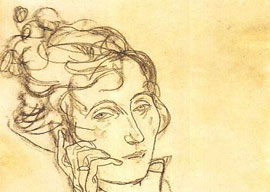
October 19, 2013

Edith Schiele, 1918
Whenever I listen to Mahler’s Das Lied von der Erde, I hear not just a song cycle of unsurpassed melancholy or even despair, but the cataclysmic collapse of a civilization that was to take place only three years after its first performance. And yet such is the beauty of the work that it reconciles us, or at least me, to that collapse, as well as to my own inevitable death. If only all cataclysms were preceded, or announced, by such works of art!
One of my favorite recordings of Das Lied von der Erde is that by Kathleen Ferrier and Bruno Walter, and one of the reasons it is so moving is that by the time she made it, Kathleen Ferrier knew that she herself was dying. The last movement, The Farewell, was indeed a farewell to the world, a farewell such as very few of us will be able to make.
I have often wondered how much knowledge of context is necessary to the appreciation of a performance or to a work of art. If it can add to it, can it detract from it? One of the most beautiful and sensitive performances of the Winterreise I ever heard was recorded in Berlin at the height, or rather the depth, of the Holocaust. One you know this it is difficult to get it out of your mind, just as when you learn that an author was a swine in his life it is difficult to read him in quite the same way, with the same enthusiasm.
Yesterday I went to an exhibition at the National Gallery in London called Facing the Modern: The Portrait in Vienna 1900. The exhibition has been much criticized as being chaotic and ill-curated, and for displaying works of artistic mediocrity next to masterpieces. I am not sure that this last criticism is a good one, even if true, for how do we appreciate masterpieces except by comparison with the mediocre?
The mediocre in life has an important function. We need relaxation from the peaks of experience, which otherwise would not be peaks but a very high plateau where the air becomes thin. And a historical survey such as this exhibition purported to be could hardly have done justice to the artistic reality of the time by displaying only what we now consider to be great, no more than the real history of medicine can consist only of the outstanding discoveries of brilliant doctors. I mean my profession no disrespect when I say that not all doctors are brilliant and that most of them make no contribution whatsoever to the advancement of knowledge, but they are a part of the history of medicine nonetheless, whether they realize it or not.
The most moving work in the exhibition, for me as for many critics, was that of Egon Schiele, who drew his wife, six months pregnant, on her deathbed a few days before the armistice in 1918 and the Austrian Empire collapsed to the great detriment of Europe. It is of a woman alert but exhausted, scarcely with the strength to keep her eyes open, emaciated, turned almost reproachfully toward the viewer. For a moment I felt almost guilty at being so healthy at twice the age at which she died. What had I done to deserve so much more fortunate a fate?
Three days after he drew this sketch, the artist himself was dead, aged only twenty-eight, and of the same disease: the Spanish flu, the epidemic of which was to kill many more millions than the Great War itself. The question is whether anyone would have found Schiele’s sketch of his wife a fraction as moving if the context were unknown to him? I tried to imagine how I should have responded to the sketch in the absence of that knowledge, a task almost impossible: One cannot unknow what one knows, as the first story about human beings in the Bible informs is.